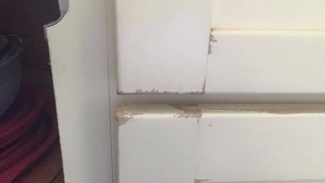


If your current finish is chipping, it is failing to adhere correctly. The adhesion problem could be caused by several reasons:
GF advises extra care and prep when applying any finish over laminate surfaces because they are specifically designed not to mar and therefore they are not very "sand-able", making adherence difficult.
In addition to this non-permeable surface factor, General Finishes Gel Stain is an oil-based product, and it is more difficult to obtain proper drying characteristics over a dense manufactured surface such as laminate. Gel stains, as all wood stains, were formulated to go over raw wood which has an "open" surface and can absorb some of the stain.
There is no easy solution to this problem. General Finishes Milk Paint has strong adhesion properties but there are several reasons this finish could fail:
If your current finish is chipping, it is failing to adhere correctly. The adhesion problem could be caused by several reasons:
Vinyl or paper veneers can be often found on the end returns of lower price-point cabinets. We cannot guarantee that our paints will adhere well to a paper veneer - we have no idea what the actual material is or what adhesives were used to apply the veneer to the surface. The resins and additives in our paints may break down the adhesives used for the veneer.
And Milk Paint does NOT adhere to vinyl.
Although some companies promote their products as "no prep", that is nonsense. If you skip this step the finish can fail.
General Finishes standard for a good finish is it must adhere well and stand the test of time.
1. PREP CLEANING:
Cleaning an existing finish removes dirt, grime and many common contaminants such as oil from hands. Dirt, grime, and oil prevent good adhesion causing the possibility of chipping, peeling and flaking - all signs of a failed finish.
Although some companies promote their products as "no prep," that is nonsense. If you skip this step the finish can fail. General Finishes's standard for a good finish is it must adhere well and stand the test of time.
This response is true of prepping and existing finish on furniture, but kitchen cabinets are more problematic because they are work areas where grease, steam, food splatters and oil from hands are common. Prep is basically degreasing and abrading the surface for better adhesion. Oil or substances on hands really show up on a failed re-finish around doorknobs and hands if the surface is not cleaned thoroughly.
It would depend on whether you plan to use the furniture outside or under the protection of a roof. Theoretically, both water and oil-based products could be used.
For example, you could "antique" wicker with thinned Gel Stain to pop up the color depth on an aging piece of natural wicker. However, Gel Stain is not exterior-rated and is very thick, making it cumbersome to apply and wipe off on a highly textured surface such as wicker.
Brushable White Enamel can be applied to raw wood or existing finishes. When applying over an existing finish, be sure to prep your surface properly.
Learn how to properly prep existing finishes by watching this video.